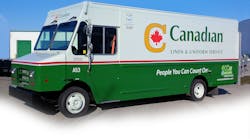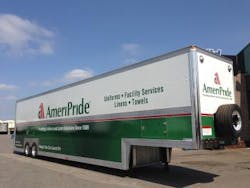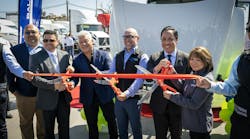A little here and a little there adds up to a lot of improved fuel economy and emissions cuts. Uniform and linen supply company AmeriPride Services is taking that approach with its 1,900-vehicle fleet as it begins to dip its toes into the world of alternative power.
Employing one of the “newest fleets in the industry,” according to Ben Saukko, director of communications, the Minnetonka, MN-based private fleet deploys 15 compressed natural gas, five propane autogas, and six electric-hybrid vehicles. It will be adding all-electric step vans in the next six months, and the majority of its diesel-fueled fleet is capable of running biodiesel.
AmeriPride also re-engineers routes on a regular basis and worked with a supplier to develop a custom double-deck semi-trailer to double efficiency. The fleet mix is growing as well. AmeriPride fleet manager Banny Allison says that by the end of this year, it will have about 100 CNG and propane-powered vehicles.
“We’ve been testing everything by modeling it first to see if it will work and if it does, we start [putting vehicles in the appropriate applications],” says Allison. “We don’t expect there to be one solution.”
The latest test features a hydraulic hybrid system from Lightning Hybrids. The system has been added to a 2014 Ford F-59 equipped with a Morgan Olson Route Star walk-in van body. The van will be in operation at an AmeriPride Canadian Linen branch in Toronto. Allison says two more test vehicles will be in place by the end of this month. Testing will last into the fall.
Lightning Hybrids explains that its system is attached to the driveline of the vehicle and captures braking energy. Through hydraulic pumps and a lightweight accumulator, fuel efficiency is gained by regenerating the braking energy that is normally lost and using this energy instead of the internal combustion engine for acceleration, the company says.
The more braking of the vehicle, the higher the payback, Allison explains. “The routes these vehicles are going to be on will have about 40 customer [stops] a day. With stoplights, stop signs and traffic, we’re estimating the vehicle may come to a stop about 150 times a day. It could be more.”
Each delivery van traverses between 14,000 and 16,000 mi. per year.
“We had looked at [similar systems] a number of years ago,” he says, “but they were extremely loud. This new system is not [very loud], and we especially liked it because it is a bolt-on system. So, if we don’t like it, we can take it off.”
The goal with the hydraulic hybrids is a 20% improvement in fuel efficiency. It is too soon at this point to make any final determinations, but Allison is hopeful. He says AmeriPride is using an inthinc telematics system, which is installed in all company vehicles, to measure the performance.
AmeriPride, though, isn’t looking to a single solution to cut its carbon footprint. The company has replaced cargo vans with fuel-efficient sedans and Transit Connects where appropriate and also re-engineered its service routes to reduce mileage.
“Our manager role has changed over the years [from product delivery] to a more proactive role,” Allison says. “With that is a lot of driving to customer sites without product delivery. The majority of the [cargo vans when appropriate] were switched to the Transit Connect, which has doubled our fuel economy.”
A re-engineering of routes has also helped cut fuel usage. Because customers come and go, routes must change and a team of four people is constantly reviewing routes for the most efficient path. “We have seen numbers up to 30% to 40% reduction [in fuel usage] in branches that had not gone through a re-route in a while,” Allison notes.
There is also a zero idling policy in effect with idle-shutdown systems on vehicles. That alone has saved the company $1.2 million in fuel over the past two years, Allison adds.
To transport product from one of its 45 North American production facilities to its network of 75 service centers, AmeriPride utilizes a fleet of 75 tractor-trailers. But, because the trailers cube out due to the bulk of linens long before they hit weight limits, there was a lot of wasted efficiency.
To combat this problem, Allison worked with Mississauga, ON-based Innovative Trailer Design on a custom trailer model. There are currently four of these trailers in the fleet with plans to add between two and four each year.
“It’s a new trailer from the ground up,” Allison says. “It’s like a moving trailer, so it’s only a few feet off the ground.” Inside is a hydraulic system that lifts the product up to a second level, he explains, adding “60% more capacity” in each trailer.
Like many fleet managers, Allison believes a fleet as diverse as that of AmeriPride cannot rely on any one solution to raise its fuel economy performance, but a variety of solutions, from vehicle changes to management techniques, are already starting to show results for the company.




